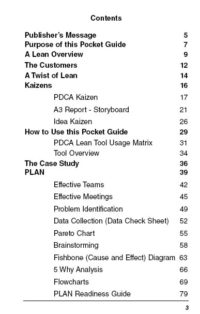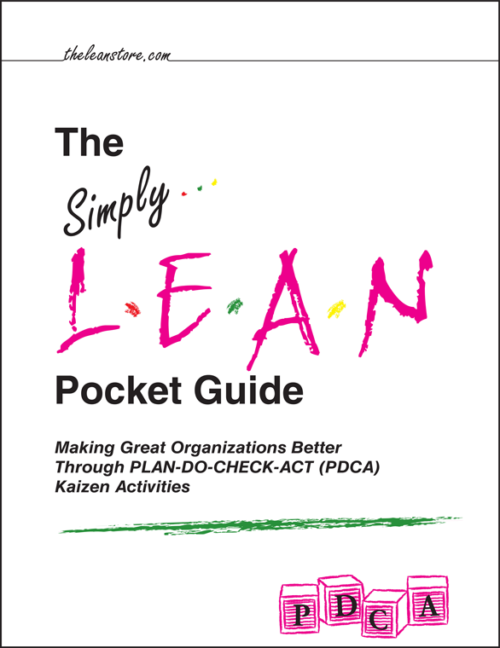First of its kind! The Simply Lean Pocket Guide is the integration of Lean and the PDCA methodology. The interactive Tinker Town case study allows you to take problem solving with a Lean twist to your next performance level.
The most basic premise of Lean is to simply and effectively problem solve. The Simply Lean Pocket Guide is a step-by-step approach to the implementation of process improvements using the PDCA model along with a Lean twist. If you are just beginning to adopt Lean or Six Sigma as a business improvement model, whether you are in the healthcare, financial services, construction, armed services, manufacturing, government, logistics, service, or construction industry, the first thing that should be acknowledged is that the solution to the problem (or improvement target that is to be reached) will be found in the intellect of the people who are working the process. Therefore, as a trainer, consultant (internal or external), or departmental head, the focus to improve a situation would be to “somehow” work with that group (and their intellect) and find a solution. However, that “somehow” is not always easy to attain and will require some guidance along the way.
-
Sale!
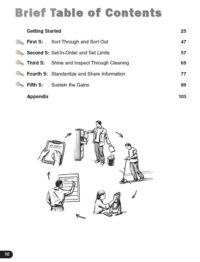
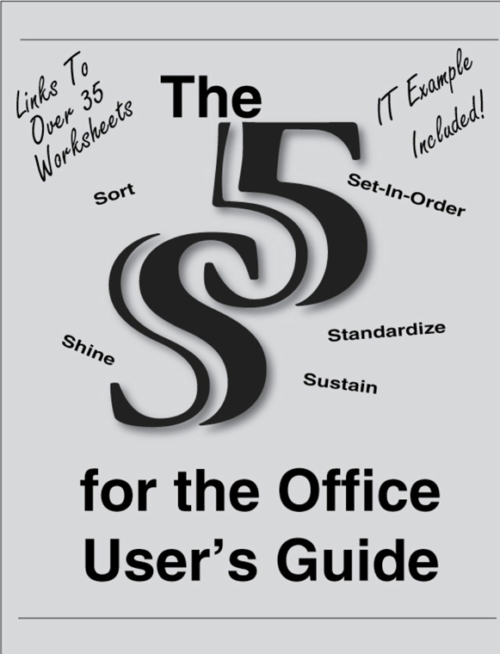 The 5S for the Office User's Guide provides an organization with the forms, worksheets, and checklists necessary to ensure a 5S project is well-planned from the start - as well as ensuring the program is sustained over time. This how-to guide should be used as it is titled - as a "Guide". The information contained in this workbook should supplement, support, and enhance, etc. current materials that an organization may currently be using. Throughout The 5S for the Office User’s Guide there will be various quotations, performance points, references to PC file storage (the IT case study in the appendix) etc. to further invoke the overall need to do 5S in all types of administrative settings. As organizations automate more administrative functions (i.e., becoming more paperless) then there must exist that same type of organization and standardization for a physical file system as well as the computer file system. It is the focus of this User’s Guide to have the 5S principles apply to both the physical desktop (paperwork, desk layout, drawer organization, etc.) and the PC desktop (folders, files, emails, shortcuts, etc.). No workbook or guide can take the place of a person’s enthusiasm and passion to improve. However, what this guide can do is provide a good, solid foundation on what is required to effectively implement 5S in administrative settings while also spearheading efforts to bring those principles to the PC.
The 5S for the Office User's Guide provides an organization with the forms, worksheets, and checklists necessary to ensure a 5S project is well-planned from the start - as well as ensuring the program is sustained over time. This how-to guide should be used as it is titled - as a "Guide". The information contained in this workbook should supplement, support, and enhance, etc. current materials that an organization may currently be using. Throughout The 5S for the Office User’s Guide there will be various quotations, performance points, references to PC file storage (the IT case study in the appendix) etc. to further invoke the overall need to do 5S in all types of administrative settings. As organizations automate more administrative functions (i.e., becoming more paperless) then there must exist that same type of organization and standardization for a physical file system as well as the computer file system. It is the focus of this User’s Guide to have the 5S principles apply to both the physical desktop (paperwork, desk layout, drawer organization, etc.) and the PC desktop (folders, files, emails, shortcuts, etc.). No workbook or guide can take the place of a person’s enthusiasm and passion to improve. However, what this guide can do is provide a good, solid foundation on what is required to effectively implement 5S in administrative settings while also spearheading efforts to bring those principles to the PC. -
Sale!
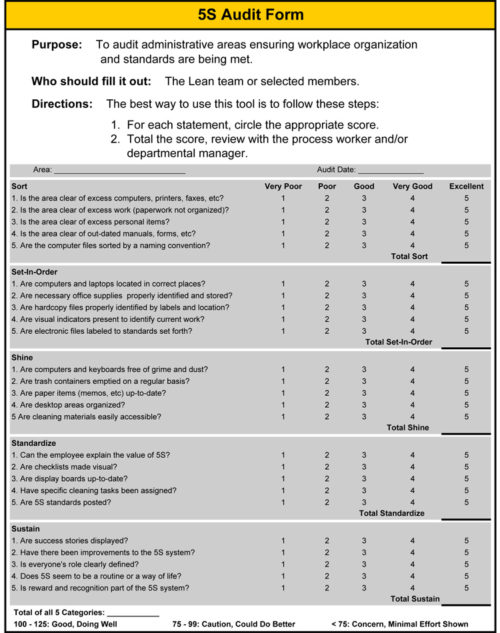
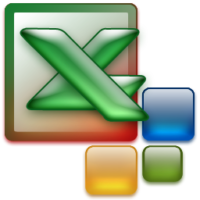 The 5S for the Office User's Guide Worksheets allow you to customize the tools, concepts, practices, and worksheets demonstrated in The 5S for the Office User's Guide. These 41 electronic worksheets will allow for more effective implementation of 5S practices in your administrative areas. Delivered as customizable Excel worksheets.
The 5S for the Office User's Guide Worksheets allow you to customize the tools, concepts, practices, and worksheets demonstrated in The 5S for the Office User's Guide. These 41 electronic worksheets will allow for more effective implementation of 5S practices in your administrative areas. Delivered as customizable Excel worksheets. -
Sale!
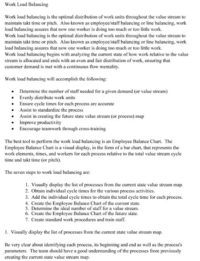
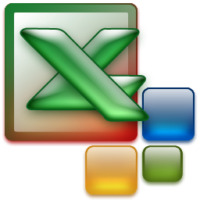 Work load balancing is the optimal distribution of work units throughout the value stream to maintain takt time or pitch. Also known as employee/staff balancing or line balancing, work load balancing assures that now one worker is doing too much or too little work. Work load balancing begins with analyzing the current state of how work relative to the value stream is allocated and ends with an even and fair distribution of work, ensuring that customer demand is met with a continuous flow mentality. The Employee Balance eTool will make this process easier by allowing you to enter the various process activities and cycle times, as well as automatically displaying them in bar graph form. This eTool is a fully customizable Microsoft Excel file. Everything is here and ready for you to get started!
Work load balancing is the optimal distribution of work units throughout the value stream to maintain takt time or pitch. Also known as employee/staff balancing or line balancing, work load balancing assures that now one worker is doing too much or too little work. Work load balancing begins with analyzing the current state of how work relative to the value stream is allocated and ends with an even and fair distribution of work, ensuring that customer demand is met with a continuous flow mentality. The Employee Balance eTool will make this process easier by allowing you to enter the various process activities and cycle times, as well as automatically displaying them in bar graph form. This eTool is a fully customizable Microsoft Excel file. Everything is here and ready for you to get started! -
Sale!
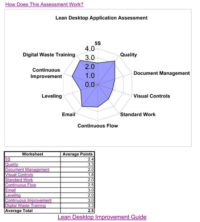
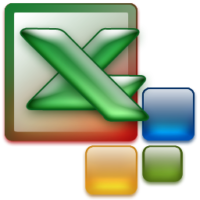 The Lean Office Assessment was created allowing a departmental work group or individual to continually assess their Lean or continuous improvement initiatives. The Lean Office Assessment is a customizable Microsoft Excel spreadsheet that will provide a baseline from which you can then improve your administrative processes. It also can assist in determining which Lean tools may be of value during a continuous improvement project. The Lean Office Assessment has 10 Lean building block categories that are further divided into 34 sub-categories that are individually scored. All categories are automatically linked to the Overview page which displays a Radar (or Spider) Chart of the total category scores. The score will assist you into allocating the appropriate resources in your Lean project. When conducting the Assessment the work group or individual must relate their database management procedures and Microsoft Office practices to the overall concepts and tools referenced. The 10 categories are: 5S, Quality, Physical Layout, Visual Controls, Standard Work, Continuous Flow, Pull Systems, Leveling, Continuous Improvement, and Training.
The Lean Office Assessment was created allowing a departmental work group or individual to continually assess their Lean or continuous improvement initiatives. The Lean Office Assessment is a customizable Microsoft Excel spreadsheet that will provide a baseline from which you can then improve your administrative processes. It also can assist in determining which Lean tools may be of value during a continuous improvement project. The Lean Office Assessment has 10 Lean building block categories that are further divided into 34 sub-categories that are individually scored. All categories are automatically linked to the Overview page which displays a Radar (or Spider) Chart of the total category scores. The score will assist you into allocating the appropriate resources in your Lean project. When conducting the Assessment the work group or individual must relate their database management procedures and Microsoft Office practices to the overall concepts and tools referenced. The 10 categories are: 5S, Quality, Physical Layout, Visual Controls, Standard Work, Continuous Flow, Pull Systems, Leveling, Continuous Improvement, and Training. -
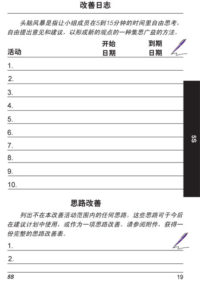
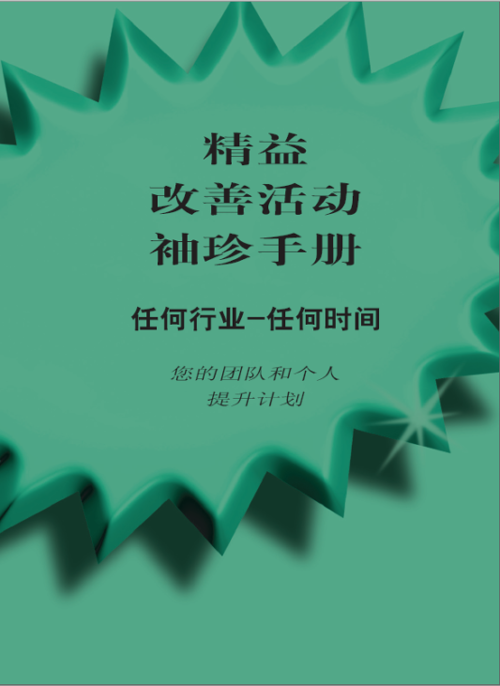 The Lean Pocket Handbook for Kaizen Events (Chinese Edition) is your personal (i.e., individual) Lean planner for the 21st century. We have found individuals that use this pocket handbook feel more part of the Kaizen team. They also continue to contribute improvement ideas well past the formal team Kaizen Event. That is what Lean is all about - making those small, incremental, improvements daily (i.e., hour-by-hour and minute-by-minute) by those closest to the process. Paperback - 3.75" x 5.5" - 96 pages
The Lean Pocket Handbook for Kaizen Events (Chinese Edition) is your personal (i.e., individual) Lean planner for the 21st century. We have found individuals that use this pocket handbook feel more part of the Kaizen team. They also continue to contribute improvement ideas well past the formal team Kaizen Event. That is what Lean is all about - making those small, incremental, improvements daily (i.e., hour-by-hour and minute-by-minute) by those closest to the process. Paperback - 3.75" x 5.5" - 96 pages -
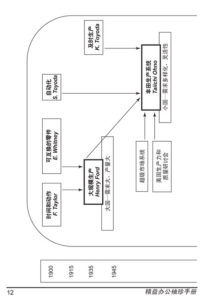
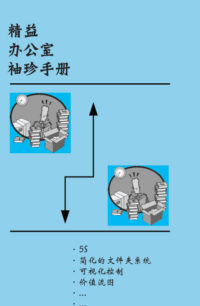 The Lean Office Pocket Handbook (Chinese Edition) is a quick-reference guide covering the terms, concepts, benefits and techniques for the application of Lean in administrative areas of all industry types. It is easy to follow, simple in its concepts, and, above all, practical to use. The tools of 5S, continuous flow, office layout, value stream mapping, process mapping, problem solving, kanbanning office supplies, kaizen, plus numerous other Lean tools are defined in terms that relate to the administrative environment. Paperback - 3.75" x 5.5" - 80 pages
The Lean Office Pocket Handbook (Chinese Edition) is a quick-reference guide covering the terms, concepts, benefits and techniques for the application of Lean in administrative areas of all industry types. It is easy to follow, simple in its concepts, and, above all, practical to use. The tools of 5S, continuous flow, office layout, value stream mapping, process mapping, problem solving, kanbanning office supplies, kaizen, plus numerous other Lean tools are defined in terms that relate to the administrative environment. Paperback - 3.75" x 5.5" - 80 pages -
Sale!
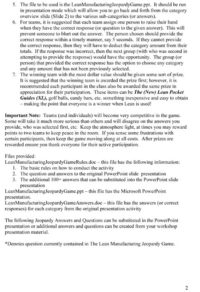
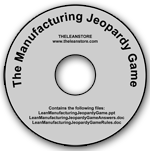 The Lean Manufacturing Jeopardy Game is a highly-engaging game to reinforce Lean concepts presented throughout a training session or workshop. This activity is typically conducted at the end of a training session. Lean Jeopardy allows for the group to be energized with the information that had been presented, while at the same time having fun in a competitive manner. The Lean Manufacturing Jeopardy Game has four categories, What is it?, Why use it?, Where use it?, and Picture this? with 5 answers for each category. There is also an additional 100 answers provided in a Microsoft Word file from which you can cut and paste into the PowerPoint file for newer versions as you see fit. The new questions are referenced from The New Lean Pocket Guide (XL).
The Lean Manufacturing Jeopardy Game is a highly-engaging game to reinforce Lean concepts presented throughout a training session or workshop. This activity is typically conducted at the end of a training session. Lean Jeopardy allows for the group to be energized with the information that had been presented, while at the same time having fun in a competitive manner. The Lean Manufacturing Jeopardy Game has four categories, What is it?, Why use it?, Where use it?, and Picture this? with 5 answers for each category. There is also an additional 100 answers provided in a Microsoft Word file from which you can cut and paste into the PowerPoint file for newer versions as you see fit. The new questions are referenced from The New Lean Pocket Guide (XL). -
Out of stock
 First of its kind! The Simply Lean Pocket Guide for Construction is the integration of Lean and the PDCA methodology. The actual case study of Midway Construction demonstrates specifically how problem solving and Lean were used in achieving significant results involving various aspects of the construction industry. The case study - along with the detailed descriptions of the quality improvement tools (with a Lean twist as explained in the case) allows you to take your organization to your next performance level.
First of its kind! The Simply Lean Pocket Guide for Construction is the integration of Lean and the PDCA methodology. The actual case study of Midway Construction demonstrates specifically how problem solving and Lean were used in achieving significant results involving various aspects of the construction industry. The case study - along with the detailed descriptions of the quality improvement tools (with a Lean twist as explained in the case) allows you to take your organization to your next performance level.
NOTE: We are only providing this book as Print On Demand (POD) which requires a minimum order of 100 books. Please call 734-475-4301 to place your order. If you require less than that, please consider The New and Improved Lean Office Pocket Guide or The Simple Lean Pocket Guide.
-
Sale!
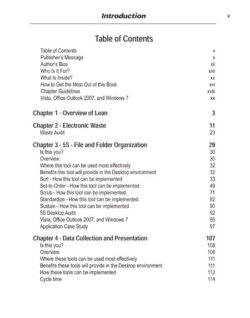
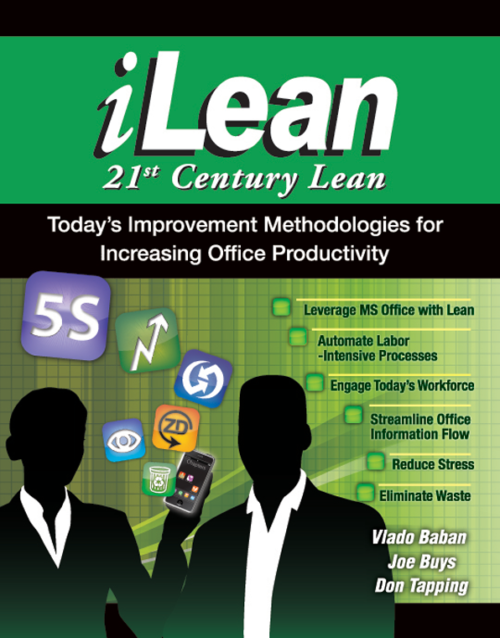 By: Vlado Baban, Joe Buys, and Don Tapping
By: Vlado Baban, Joe Buys, and Don Tapping
iLean's content will provide actual case studies, application examples, and working macros that have proven successful in improving information flow in all types of environments. iLean was arranged in a format that should provide you with enough detailed guidance (step-by-step instructions) to apply a similar-type Lean practice to your work process. Starting with Chapter 3, each chapter begins with a section titled Is this you? which was specifically designed to assist you in determining if that chapter has immediate relevancy to your current work challenges. Subsequently, it is suggested that a formal standard improvement methodology, Six Sigma's Design-Measure-Analyze-Improve-Control (D-M-A-I-C), Edward Deming's Plan-Do-Check-Act (PDCA) or some other similar methodology be used if a formal structure is required and/or more statistical analysis needs is required. However, many of the concepts and tools presented throughout this book can be implemented by an individual worker and, therefore, will not require a formal process (other than good project management skills). Microsoft s Office suite of products of Word, Excel, and Outlook, as well as Open Source applications of vTiger, Google Docs, and Huddle, are referenced throughout this book to provide an overall understanding of how Lean can be used to move information faster and more accurately than ever before. In doing so, you will be able to reduce inter-office dependencies, delays, and errors that may be present in your current business processes. -
Sale!
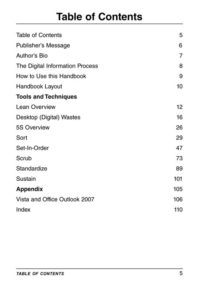
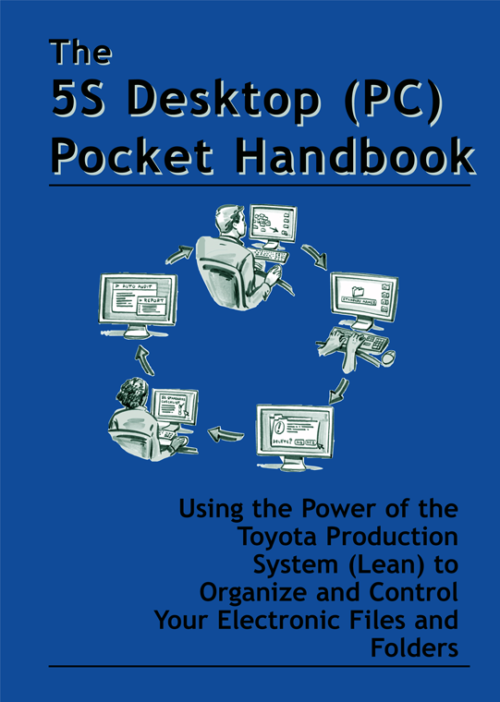 By: Vlado Baban
By: Vlado Baban
The 5S Desktop (PC) Pocket Handbook is a step-by-step guide for the implementation of 5S to all your electronic files. The XP version of Windows Explorer and the Office 2003 software suite were the versions used in creating this handbook. This handbook is designed to be:- An implementation guide. This handbook steps you through each phase of the 5S process. Examples are shown to assist you in this process. No two file systems (Desktops) are the same; therefore, use the examples as a guide when you apply that phase or step to your Desktop.
- A Lean beginning. 5S is a fundamental Lean tool and is considered the foundation for additional Lean tool application. Once 5S has been implemented and results have been obtained, there will be a need to integrate more Lean tools into your Desktop environment.
- A spark for the department. Once everyone understands the basic premise of Lean and 5S, then that understanding can serve as a catalyst for a more comprehensive application of Lean tools. (iLean and Lean Office Demystified II are available books on how additional Lean tools can be applied to your Desktop environment.)
- A bridge for improved performance. It is often stated that the average person at work today has nearly 80 emails to deal with on a daily basis. This, along with the other application files, can at times be overwhelming for the individual. Using 5S for organizing your emails, as well as the other application files, will greatly assist in managing this barrage of information. Implementing 5S to your files and folders will allow for a more stress-free workplace.
-
Sale!
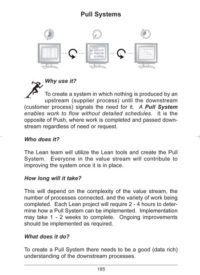
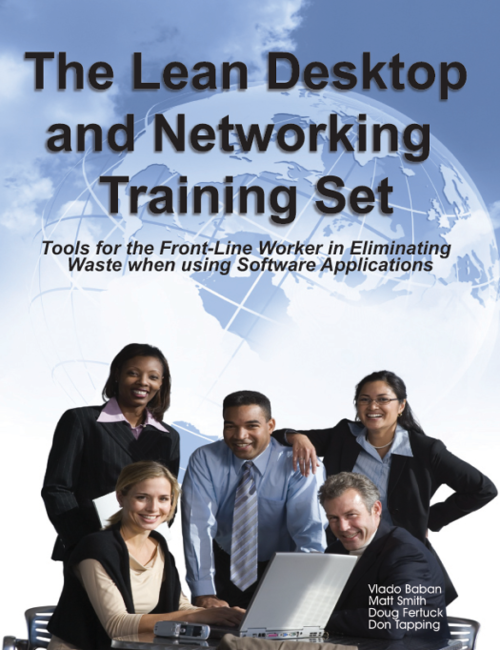 By: Vlado Baban, Doug Fertuck, Matt Smith, Bob Angeli (P.E.), and Don Tapping
By: Vlado Baban, Doug Fertuck, Matt Smith, Bob Angeli (P.E.), and Don Tapping
The Lean Desktop and Networking Pocket Guide XL is designed to be a convenient, quick reference book providing valuable insight into how Lean can be applied to data as it is pulled, analyzed, formatted, and sent through various Desktop and networking applications. The Lean Desktop and Networking Pocket Guide XL details the application of Lean (i.e., the tools and concepts derived from the Toyota Production System), that when leveraged with Microsoft Office and Open Source applications, can assist to better manage data on a daily basis while improving office productivity. Desktop Lean will create a new generation of "power users" and enhance a typical office worker's ability to work individually, as well as collaborate in work group type situations. This "new" power user is a person that readily learns new applications while integrating Lean tools and concepts to eliminate all process waste.

